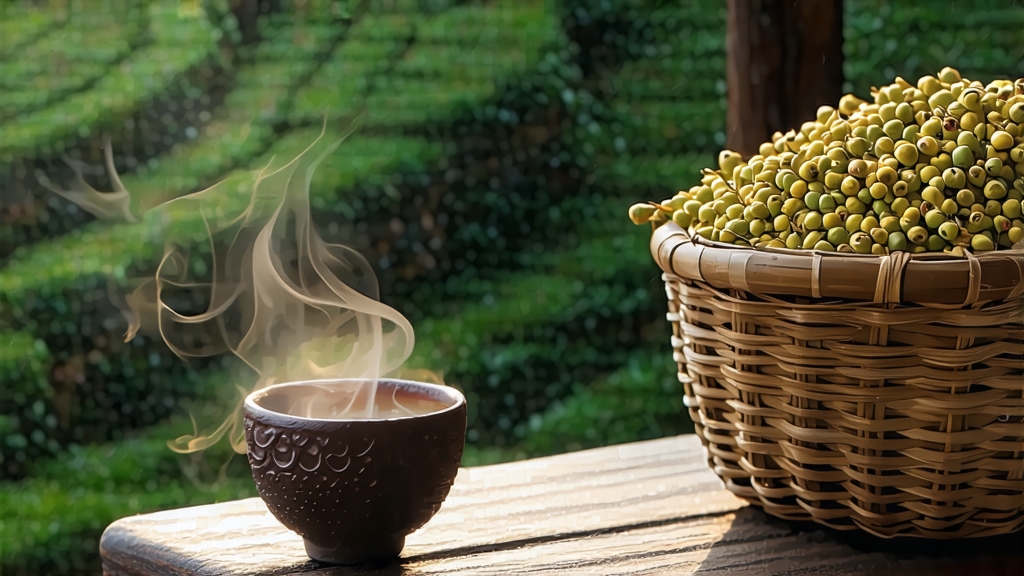
Meng Ding Huang Ya, literally “Yellow Bud from Meng Summit,” is the least exported yet most aristocratic member of China’s micro-category of yellow tea. For more than twelve centuries it has been picked on the summit of Meng Ding, a 1 450 m granite shoulder of the Qinghai-Tibetan plateau that pushes its granite snout into the moist belly of Sichuan Basin. The mountain’s fourteen perennial waterfalls keep relative humidity above 85 % even at noon, while the gorge funnels warm mist upward, creating the cool-warm oscillation that yellow tea needs to “smother” itself into golden elegance. International drinkers who meet it for the first time often mistake it for a premium green tea, but one sip reveals a round, almost custard-like sweetness that green tea never attains. This article walks you from Tang-dynasty tribute lists to the exact gram-to-water ratio you should use in a Paris apartment, unpacking why Meng Ding Huang Ya is considered the “soft whisper” among China’s six tea families.
-
A leaf born in poetry, paid in salt
The first written record appears in 825 CE when the Tang governor of Yazhou (today’s Ya’an) sent 116 pounds of “Meng Mountain Yellow Sprout” to Chang’an, paying his land tax in tea rather than silver. By Song times the imperial Household Department fixed the levy at 400 jin (240 kg) annually, specifying buds no longer than “rice grain before boiling.” Because the mountain was sacred—legend says the Daoist master MengZi planted the first seven bushes after riding there on a white crane—plucking rights became hereditary. Even now 37 families bearing the surnames Gan, Yang and Li control the 2 300 mu (153 ha) core garden, their ancestor contracts stamped with the Ming governor’s seal. Foreigners sometimes read “yellow” and imagine a flavoured or scented tea; in fact the colour refers to the pale citrine liquor and the faint straw-yellow of the finished leaf, both outcomes of a unique micro-fermentation step invented to stabilise Sichuan’s early-spring moisture. -
One mountain, three styles
Within the protected geographical indication (PGI) drawn in 2012, Meng Ding Huang Ya is divided by elevation and plucking grade:
- Summit Bud (Ding Ya, 1 300–1 450 m): 100 % single bud, downy silver-white, picked for only eight mornings after Qingming. Production is less than 600 kg a year; most is pre-sold to collectors in Shenzhen and Hong Kong.
- Valley Tip (Qiao Ya, 900–1 300 m): one bud and one just-opened leaf, the leaf still curling like a shrimp tail. This is the style most likely to appear in overseas specialty stores.
- Misty Leaf (Wu Ye, 700–900 m): one bud and two leaves, allowed a slightly longer yellowing to develop a nuttier note. It is affordable yet still recognisably “yellow.”
All three share the same cultivar—Sichuan local group #9, a small-tree type whose leaves carry 5.8 % amino acids, almost twice that of Longjing #43. The high theanine builds the famous “sweet broth” body that survives the yellowing oxidation.
- Craft: the 48-hour “wrapped dream”
After picking, the buds are laid 2 cm thick on bamboo trays and wilted for 90 minutes at 26 °C to shed field heat. The kill-green is done in 12-kg batches in drum roasters set to 160 °C for exactly 4 minutes; the goal is 55 % moisture, high enough to keep enzymes alive for the critical next step. While the leaf is still 70 °C, it is piled into cotton bags holding roughly 1.5 kg each. The bags go into a sealed wooden chest lined with wet straw mats. Here the “men huang” (sealed yellowing) begins: for 24 hours the chest stays at 34 °C and 78 % RH, while polyphenol oxidase and peroxidase gently nibble at the chlorophyll, turning the leaf colour from vivid green to pale champagne. Every eight hours the chest is opened, bags rotated, and a handful of leaf sniffed; when the aroma shifts from fresh pea to baked pumpkin, the tea is spread out again. A second, shorter roasting